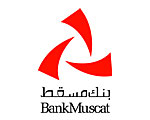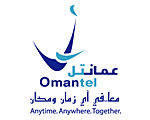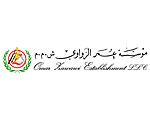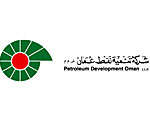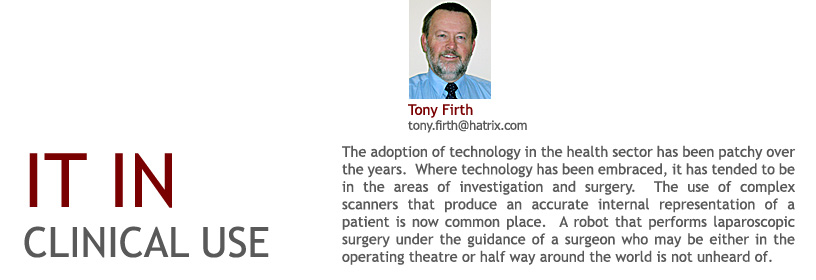
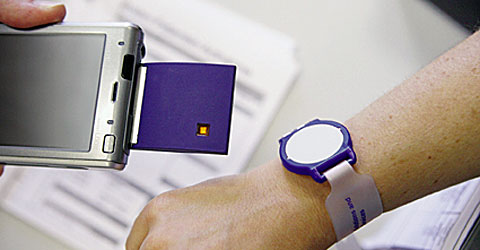
So, if this type of complex technology is embraced in some areas of healthcare, then why is IT not being adopted? IT is being used in the areas of patient management and finance with Patient Administration Systems, as well as stock management and manufacture through dispensing systems, but there has been no broad adoption of IT systems for clinical use. This is particularly so in the hospital sector.
Perhaps the main reason for the low adoption rate has been the lack of appropriate applications. Clinical applications need to deliver a benefit to the user, otherwise it can be seen as merely an obstruction. The process of a ward round in a hospital has not changed in the past 100 years. If we are to introduce something new to that process, it can cause some difficulty for various reasons, but not the least because it has the potential to slow the process down. Therefore, to convince clinicians to embrace IT it needs to deliver something beneficial.
We are now starting to see the development of clinical applications that are focussed on the processes involved in a hospital ward round. There is also development that is addressing the clinical aspects of both the hospital pharmacy and nursing. An example is the very common process in the treatment of a patient and that is the ordering of tests. The current sequence of events is that a doctor will see a patient in a ward, and then locate order forms for the pathology tests or x-rays (usually at the nurse’s station), fill them in and then leave them on the ward to be collected.
On completion of the tests or x-rays, the results are delivered back to the ward and filed in the patient’s record. Those results are then available to the doctor the next time they visit the ward. This is an inefficient process that requires the doctor to do both the ordering and result reviewing from the ward. IT has the potential to greatly streamline this process.
Systems are now available to enable the clinician to order the test online, from the patient’s bedside or in fact any computer on the system. The results can also be delivered to the doctor via e-mail or can be browsed by the doctor from any computer on the system. This breaks the nexus between the doctor’s location and the availability of the information, necessary to treat the patient.
The development of these systems is a complex process and it is important to ensure that they are fit for purpose. Not only do these systems need to perform certain functions, but they need to be able to do it in an efficient way. A good example of this not happening was the Cedars-Sinai Medical Centre in Los Angeles. They developed their own Computerised Physician Order Entry (CPOE) system at an estimated cost of RO13 million (Hospital officials have said that this estimate is too high but they have not provided an accurate figure). After implementation, its use was stopped when doctors complained that it was endangering patient safety. Reports indicated that doctors experienced problems ordering medication, tests and supplies using the software. They said the system’s complexity caused delays, inconveniences and some imprecise entries.
The Cedars-Sinai Medical Centre is taking the failure as an opportunity to improve its workflows. You can be sure that the result will be a system that is both safe to use and also improves the user’s work practices.
Workflows are an important component of the process. Working in the clinical side of a hospital is not a desk-bound job. It is quite the opposite, it is very mobile. This means that the IT solution needs to be mobile. That doesn’t necessarily mean the adoption of tablet computers or Personal Digital Assistants (PDAs). Both of these options have their benefits as well as their problems. While tablet computers are very mobile, they can also become heavy and hot particularly when used in a long ward round. They could also be easily damaged if they are put down on the patient’s bed and then the patient moves and knocks it onto the floor. PDAs may be the ultimate in mobility, but their small screen makes it difficult to display complex data. Also, data entry is more complicated for anything other than point-and-click and that is not always possible.
An effective solution may be as simple as a notebook mounted on a trolley, connected to the network via a wireless connection. This provides mobility, ease of data entry via a standard keyboard and mouse and weight and heat are not an issue.
The pace of IT adoption in the hospital sector will increase as both the applications become more functional and user friendly and the newer doctors come through the system, having just completed their university training almost totally using computers.
This quote from an 1834 edition of The London Times - commenting on the stethoscope - makes you realise that the adoption of new technology in the health sector has always been a difficult process.
“That it will ever come into general use, notwithstanding its value, is extremely doubtful because its beneficial application requires much time and gives a good bit of trouble, both to the patient and to the practitioner because its hue and character are foreign and opposed to all our habits and associations.”


